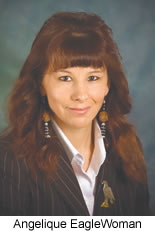 |
Canku Ota
|
 |
|
(Many Paths)
|
||
|
An Online Newsletter
Celebrating Native America
|
||
|
September 1, 2009 -
Volume 7 Number 9
|
||
|
|
||
|
Law Professor Building
Native American Program
|
||
|
by Jessie L. Bonner
- Indian Country Today
|
||
|
She was 8 and watching the television in her family’s living room in 1978 when news broke that her uncle, a black man who had married into a Native American family and was beaten by five deputies when he went pay a speeding ticket, was awarded $75,000 in punitive damages. “I knew I wanted to make my life about justice,” said EagleWoman, who grew up in Kansas and lived on a reservation in South Dakota. Roughly 30 years later, EagleWoman has built a program focusing on Native American law, an area of the legal profession that experts say is often misunderstood and sometimes ignored. “There are over 35 states that have sovereign, independent tribal nations within their boundaries, if you’re practicing in any one of those states you have to understand the basics of Indian law,” said Heather Dawn Thompson, president of the National Native American Bar Association. “It’s a little bit crazy,” Thompson said. “Alaska has over 200 tribes and it’s not on their bar exam.” It’s also not on the exam in California, where there are more than 100 tribes, and also not on the one in Oklahoma, where there are more than 40, said Thompson, a member of the Cheyenne River Sioux. Since the 1970s, only a handful of lawyers who specialize in Native American law have been available to help tribal members navigate through legal matters. “You had all sorts of attorneys that had no idea what they were talking about,” she said. Thompson said attorneys – particularly those in states with tribes – must understand there are three systems of practice: state, federal and tribal law. Each has three distinct set of rules, each has three distinct court systems. For example, if a mother dies and her child is underage, the custody would most likely go to the father under state legal proceedings and the traditional western notions of family structure. But under tribal law, the family structure is often different. In some tribes, a biological mother’s sister could be granted custody because the women share the same rights and responsibilities. The federal Indian Child Welfare Act makes sure tribal law is respected in this area of legal proceedings. “So many attorneys do not know that law exists and they break it every day,” Thompson said. “That’s a concept that’s hard for a lot of attorneys who practice family law to wrap their head around and it’s one of the reasons why the program at the University of Idaho is so important.” At the university, a campus built on the aboriginal homeland of the Nez Perce Tribe, the law school last year hired EagleWoman, who is from the Sisseton-Wahpeton Oyate of the Lake Traverse Reservation in South Dakota, commonly called Sioux. With only a handful of Native American law programs available nationwide, only three states include this area of the legal profession on the list of subjects that can be tested on the bar exam. Those states are Washington, New Mexico and South Dakota, EagleWoman said. EagleWoman studied political science at Stanford University, earned a law degree at the University of North Dakota and a masters in law at the University of Tulsa in Oklahoma. She has cross-listed her courses at the University of Idaho so students outside the law school can enroll. Last year, she taught 17 law students and two others studying American Indian studies. This fall, she’ll have 32 law students and eight others. Along with building the law emphasis curriculum, EagleWoman has also bolstered efforts to recruit more Native American students, said UI College of Law Dean Don Burnett. “She’s a tremendous asset,” Burnett said. EagleWoman hopes one day to have her program grow into a full-fledged degree. “So many attorneys had no basis in Native American law and I thought that was a travesty,” she said. |
|
|
||
|
|
||
| Canku Ota is a free Newsletter celebrating Native America, its traditions and accomplishments . We do not provide subscriber or visitor names to anyone. Some articles presented in Canku Ota may contain copyright material. We have received appropriate permissions for republishing any articles. Material appearing here is distributed without profit or monetary gain to those who have expressed an interest. This is in accordance with Title 17 U.S.C. Section 107. | ||
|
Canku Ota is a copyright ©
2000, 2001, 2002, 2003, 2004, 2005, 2006, 2007, 2008, 2009 of Vicki
Barry and Paul Barry.
|
||
 |
 |
|
|
The "Canku
Ota - A Newsletter Celebrating Native America" web site and
its design is the
|
||
|
Copyright ©
1999, 2000, 2001, 2002, 2003, 2004, 2005,
2006, 2007, 2008, 2009 of Paul
C. Barry.
|
||
|
All Rights Reserved.
|
||
 MOSCOW,
Idaho (AP) – Angelique EagleWoman remembers the moment when
she decided she wanted to devote her life to law.
MOSCOW,
Idaho (AP) – Angelique EagleWoman remembers the moment when
she decided she wanted to devote her life to law.